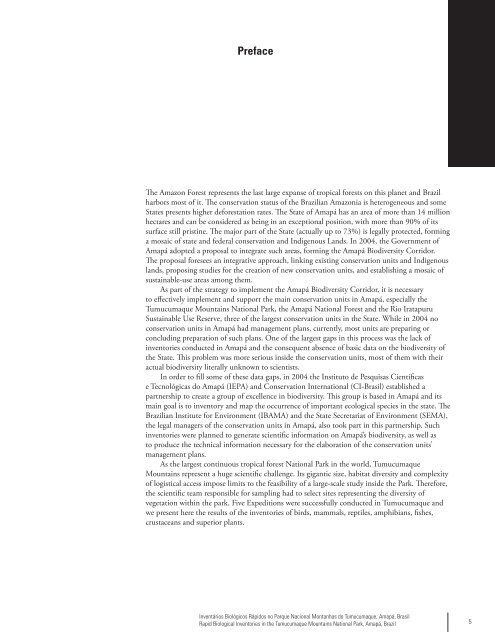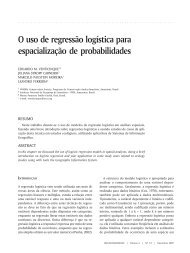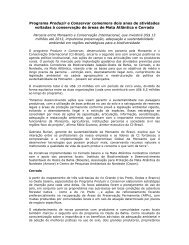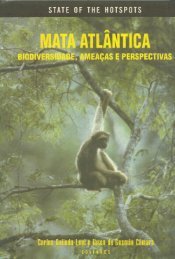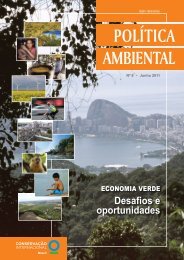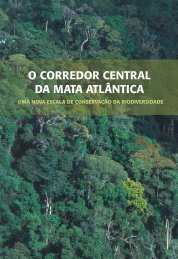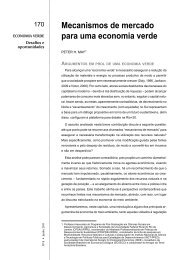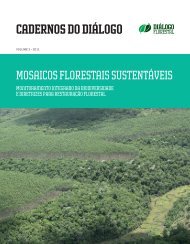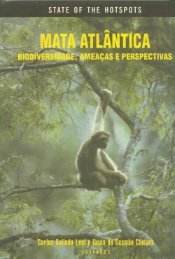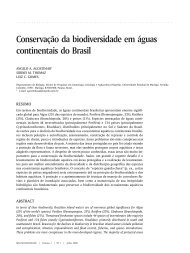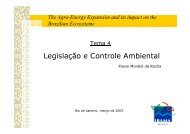Rapid Assessment Program - Conservação Internacional
Rapid Assessment Program - Conservação Internacional
Rapid Assessment Program - Conservação Internacional
Create successful ePaper yourself
Turn your PDF publications into a flip-book with our unique Google optimized e-Paper software.
Preface<br />
The Amazon Forest represents the last large expanse of tropical forests on this planet and Brazil<br />
harbors most of it. The conservation status of the Brazilian Amazonia is heterogeneous and some<br />
States presents higher deforestation rates. The State of Amapá has an area of more than 14 million<br />
hectares and can be considered as being in an exceptional position, with more than 90% of its<br />
surface still pristine. The major part of the State (actually up to 73%) is legally protected, forming<br />
a mosaic of state and federal conservation and Indigenous Lands. In 2004, the Government of<br />
Amapá adopted a proposal to integrate such areas, forming the Amapá Biodiversity Corridor.<br />
The proposal foresees an integrative approach, linking existing conservation units and Indigenous<br />
lands, proposing studies for the creation of new conservation units, and establishing a mosaic of<br />
sustainable-use areas among them.<br />
As part of the strategy to implement the Amapá Biodiversity Corridor, it is necessary<br />
to effectively implement and support the main conservation units in Amapá, especially the<br />
Tumucumaque Mountains National Park, the Amapá National Forest and the Rio Iratapuru<br />
Sustainable Use Reserve, three of the largest conservation units in the State. While in 2004 no<br />
conservation units in Amapá had management plans, currently, most units are preparing or<br />
concluding preparation of such plans. One of the largest gaps in this process was the lack of<br />
inventories conducted in Amapá and the consequent absence of basic data on the biodiversity of<br />
the State. This problem was more serious inside the conservation units, most of them with their<br />
actual biodiversity literally unknown to scientists.<br />
In order to fill some of these data gaps, in 2004 the Instituto de Pesquisas Científicas<br />
e Tecnológicas do Amapá (IEPA) and Conservation International (CI-Brasil) established a<br />
partnership to create a group of excellence in biodiversity. This group is based in Amapá and its<br />
main goal is to inventory and map the occurrence of important ecological species in the state. The<br />
Brazilian Institute for Environment (IBAMA) and the State Secretariat of Environment (SEMA),<br />
the legal managers of the conservation units in Amapá, also took part in this partnership. Such<br />
inventories were planned to generate scientific information on Amapá’s biodiversity, as well as<br />
to produce the technical information necessary for the elaboration of the conservation units’<br />
management plans.<br />
As the largest continuous tropical forest National Park in the world, Tumucumaque<br />
Mountains represent a huge scientific challenge. Its gigantic size, habitat diversity and complexity<br />
of logistical access impose limits to the feasibility of a large-scale study inside the Park. Therefore,<br />
the scientific team responsible for sampling had to select sites representing the diversity of<br />
vegetation within the park. Five Expeditions were successfully conducted in Tumucumaque and<br />
we present here the results of the inventories of birds, mammals, reptiles, amphibians, fishes,<br />
crustaceans and superior plants.<br />
Inventários Biológicos Rápidos no Parque Nacional Montanhas do Tumucumaque, Amapá, Brasil<br />
<strong>Rapid</strong> Biological Inventories in the Tumucumaque Mountains National Park, Amapá, Brazil


